Ward Parkway Mirror Pool Fountain
Introduction
Text-to-speech Audio
Designed in 1924 by architect Edward Buehler Delk, this fountain was originally created as a reflection pool and was the first water feature along Ward Parkway. The three water rings were installed in 1965. The nearly one block long pool is located in the median of Ward Parkway, one of the first major thoroughfares created in Kansas City as part of the Parks and Boulevards System. The parkway was created in correlation with the development of J.C. Nichols’ Country Club Plaza district and other neighborhoods in plans to expand the suburbs southward. It features an array of beautiful landscaping and ornate statuary that landed it as one of ten “Great Streets” in 2012 by the American Planning Association.
Images
The Ward Parkway Mirror Pool Fountain.
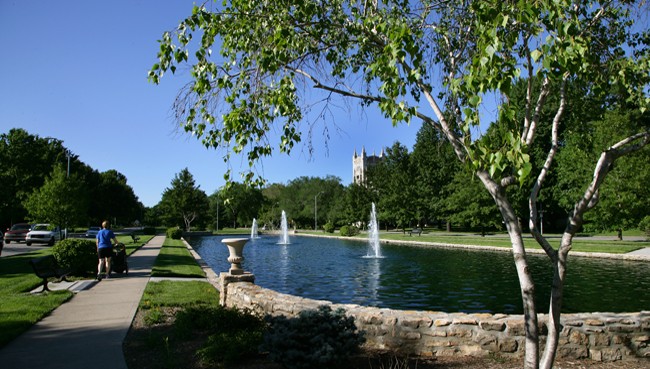
A plaque at the north end of the Ward Parkway Mirror Pool Fountain commemorates Ward Parkway's designation as a Great Street.
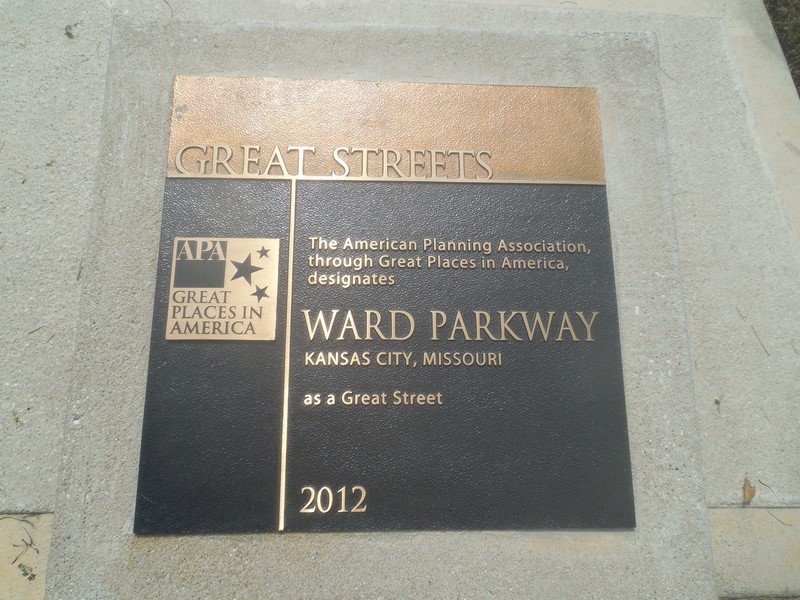
The Ward Parkway reflection pool c.1930. Courtesy of Missouri Valley Special Collections, Kansas City Public Library, Kansas City, Missouri.
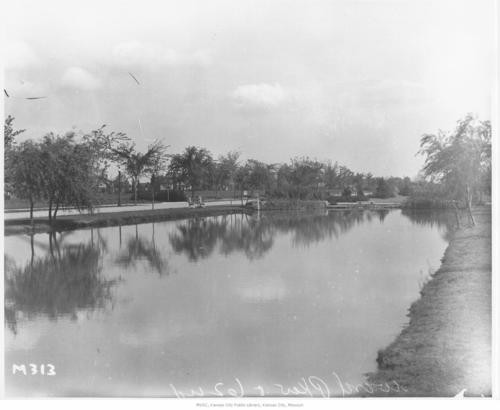
The Ward Parkway reflection pool c.1932 shows the implementation of landscape design. Courtesy of Missouri Valley Special Collections, Kansas City Public Library, Kansas City, Missouri.
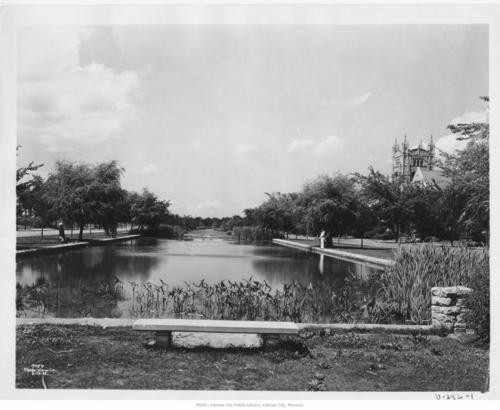
A sailboat race at the Ward Parkway reflection pool (date unknown). Courtesy of Missouri Valley Special Collections, Kansas City Public Library, Kansas City, Missouri.
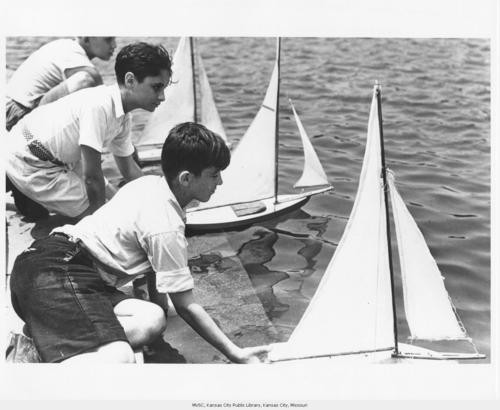
An example of the development of Ward Parkway seen here at 57th Street c.1914. Courtesy of the State Historical Society of Missouri.
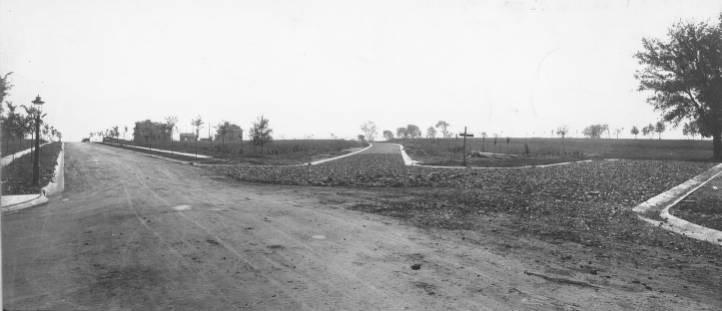
An aerial view of Ward Parkway from 61st Terrace looking north c. 1925. Courtesy of the State Historical Society of Missouri.
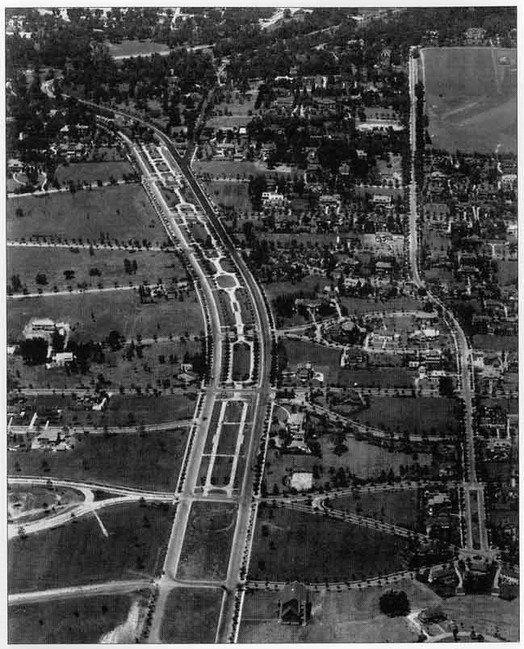
Landscape architect George Kessler.
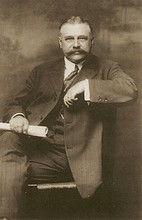
Architect Edward Buehler Delk. Courtesy of Missouri Valley Special Collections, Kansas City Public Library, Kansas City, Missouri.
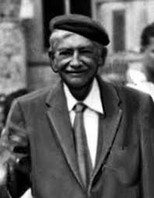
Backstory and Context
Text-to-speech Audio
Ward Parkway was designed by premier landscape architect George Kessler in 1913 as part of the Kansas City Parks and Boulevard System. It follows the natural path of the landscape, starting at Mill Creek Parkway in the Country Club Plaza shopping district, then curving west-southwest and travels south to around 92nd Street before making a final curve and ending at Wornall Road. The 12-mile stretch of parkway features a wide median full of landscaped green space, fountains, and statuary, and is lined with historic properties. In 2012, Ward Parkway was designated as one of ten ‘Great Streets’ by the American Planning Association for exemplifying exceptional character. A plaque at the north end of the pool commemorates the designation.
The City Beautiful Movement was a major aspect in the implementation of the Parks and Boulevards System as it transformed the landscape along the major thoroughfares. The first water feature to be installed along Ward Parkway was a reflection pool designed by notable architect Edward Buehler Delk. Taking up nearly an entire block in the median between W 61st Terrace and W 62nd Street, this pool was occasionally used for ice skating and miniature boat races. In 1965 the pool was renovated, including the addition of three water spray rings. The rings were placed centrally within the pool, giving symmetry to the large fountain.
George Kessler (1862-1923) was born in Germany and moved to the United States with his family in 1978. He returned to Europe to study landscape architecture and civil engineering before coming back to the states in 1882. He was first hired by the Fort Scott and Gulf Railway Company to design and supervise the construction of Merriam Park in Kansas. He then opened an office across the state line, in Kansas City, Missouri, and sought out other work. In 1887, he was commissioned for the development of Hyde Park, located in the largest planned single-family home development at the time. He transformed the rugged, overgrown limestone hollow into a beautiful park. In the years to come, Kessler began advocating for city improvements and in 1892, the Kansas City Parks Board was created. The following year Kessler performed an assessment on the city’s topography and with board president August Meyer, developed the Parks and Boulevard System - the most notable accomplishment of his career. His work can also be seen in Saint Louis, Dallas, Denver, Memphis, and Indianapolis. Kessler was also the landscape architect chosen for the Liberty Memorial, but passed away before it was completed.
Edward Buehler Delk (1885-1956) first came to Kansas City in 1920 when J.C. Nichols commissioned him as a consulting architect for the Country Club Plaza, the first shopping center in the country designed for the automobile. He designed many of the first buildings in the shopping center, including the Sudyam Building (now Mill Creek Building) and the Tower Building. Throughout his career he designed commercial buildings, churches, and private residences primarily in Missouri and Oklahoma. Some of his notable work includes the Starlight Theatre (Kansas City, 1951), LaQuinta mansion (Bartlesville, OK, 1932), and Community Christian Church (Kansas City, MO, 1950) which he took over from Frank Lloyd Wright. In addition, he designed Villa Phillbrook, the residence of co-founder of Phillips Petroleum Waite Phillips, (now the Philbrook Museum of Art, Tulsa, OK, 1927) and the Philtower Building (Tulsa, OK, 1928) which have been accepted to the National Register of Historic Places.
Cite This Entry
Stahly, Nichole. "Ward Parkway Mirror Pool Fountain." Clio: Your Guide to History. July 20, 2022. Accessed March 21, 2025. https://theclio.com/tour/2255/27
Sources
Ward Parkway Mirror Pool Fountain, City of Fountains. Accessed July 20th 2022. https://cityoffountains.org/ward-parkway-mirror-pool-fountain/.
Ward Parkway, KC Parks. Accessed July 20th 2022. https://kcparks.org/places/ward-parkway/.
Worley, William S.. A Legacy to a City: Kansas City Architects George Kessler, Henry Wright, and Sid and Herbert Hare. Kansas History, ser. Autumn 1997, vol. 20, no. 3192 - 205. Kansas Historical Society.
Edward Buehler Delk, AIA (1885-1956), Tulsa Architecture. Accessed July 20th 2022. https://tulsaarchitecture.org/architects/edward-buehler-delk-aia-1885-1956/.
Ford, Susan Jezak. Biography: Edward Buehler Delk, Architect, 1885-1956, Kansas City Public Library. Accessed July 20th 2022. https://kchistory.org/document/biography-edward-buehler-delk-1885-1956-architect.
Biography, George E. Kessler. Accessed July 20th 2022. http://georgekessler.org/index.php?option=com_content&view=section&id=5&Itemid=53.
https://kcparks.org/places/ward-parkway/
https://cityoffountains.org/ward-parkway-mirror-pool-fountain/
https://kchistory.org/image/ward-parkway
https://kchistory.org/image/ward-parkway-1
https://kchistory.org/image/sailboat-race
https://cdm17228.contentdm.oclc.org/digital/collection/imc/id/17690/rec/2
https://shsmo.org/sites/default/files/pdfs/kansas-city/kimball/Haskell-2008-04-10.pdf
https://en.wikipedia.org/wiki/George_Kessler
https://kchistory.org/document/biography-edward-buehler-delk-1885-1956-architect

